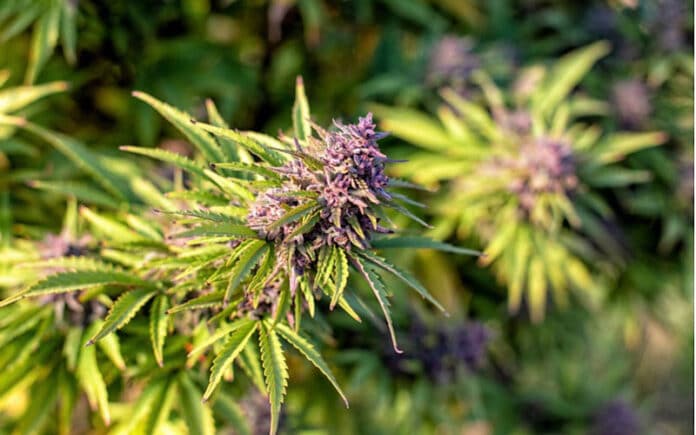Despite a cool, wet start to the growing season, the pot plants were already chest high by mid-July at WeedMD Inc.’s farm in southwestern Ontario, a region better known for producing fruit and corn than cannabis.
WeedMD is one of 13 Canadian pot companies that have been granted outdoor cultivation licenses in an industry that predominantly grows in greenhouses or warehouses. It has planted 21,000 plants on 27 acres that formerly grew asparagus, and expects to harvest more than 25,000 kilograms (55,000 pounds) of dried pot from its outdoor operations this year, more than half its total production.
The amount of outdoor-grown cannabis will make up a small portion of the market this year — less than 10% of the cultivation licenses granted in Canada are for outdoors — but many more are in the pipeline after the Canadian government changed its rules last year to allow pot farms.
The appeal is clear: growing outdoors can cost as little as one-fifth that of greenhouse production and it can be marketed as being grown “au naturel” under the sun. It can also carry higher risk from pests, pesticides and weather.
“Growing outside is a dream,” said Derek Pedro, chief cannabis officer at WeedMD, during a tour of the farm in Strathroy, about 225 kilometers (140 miles) from Toronto. He said the natural changes in light and temperature outside result in “bigger, tastier, denser” buds with a better high than the same strain grown in a greenhouse.
As recently as a year ago many companies were disparaging outdoor-grown pot.
“Restricting the cultivation of cannabis to indoor facilities, both greenhouse and buildings, will ensure a safe and secure production environment,” Bruce Linton, then co-chief executive officer of Canopy Growth Corp., told a Canadian Senate hearing in May 2018, pointing to the potential for theft and low-quality product outdoors.
Thirteen months after that hearing, Canopy announced it had received a license to grow outdoors in northern Saskatchewan.
Earlier opposition was “propaganda,” said Jeannette VanderMarel, co-CEO of 48North Cannabis Corp., which received one of the first outdoor cultivation licenses for a farm in Brant County, Ontario, with a potential capacity of 40,000 kilograms. The company also has a small indoor cultivation facility and a processing and manufacturing plant.
“They’ve sunk hundreds of millions into indoor facilities and greenhouses, and it’s really tough for them to then backtrack and say a milligram of THC is a milligram of THC, it doesn’t matter if you grow it in the Taj Mahal or outside in a field,” VanderMarel said in a phone interview.
Growing outdoors eliminates the need for costly lighting, heating and cooling systems. VanderMarel at 48North estimated that it costs the company 25 cents a gram to grow outdoors. WeedMD CEO Keith Merker said it can grow for about 20 cents at its farm versus $1 a gram in a greenhouse and $2 a gram for a typical indoor site.
Critics say outdoor cannabis is more susceptible to pest infestations and contamination from pesticides at neighboring farms. Detractors also say the long Canadian winters don’t make the country ideal for growing pot, with the plant better suited to the benign climate of places like California, where outdoor growing is widespread.
This is why some companies are taking a more cautious approach to growing outdoors. Aurora Cannabis Inc. last month received licenses for outdoor cultivation in Quebec and British Columbia, but is taking a go-slow approach to test the best growing methods and genetics before deciding whether it wants to embark on large-scale farming.
“It’s sort of like two sides of the same coin: the disadvantage of outdoor is you can’t control the environment if there’s an early frost and your crop gets hit hard and killed, but the disadvantage of indoor is you’re paying for the electricity to make sure the frost doesn’t get those plants,” said Jonathan Page, chief science officer at Aurora.
Lower Cost
Most farm-grown pot will be used in products like edibles, beverages and vape pens, where the quality of the original plant matters less than in smokable dried-flower.
This means it’s likely to be the lowest-margin cannabis on the market, said Elliot Johnson, chief investment officer at Evolve ETFs, which runs the actively managed Evolve Marijuana Fund.
“There’s no question about it that outside-grown product is going to be the most commoditized part of the industry,” Johnson said. However, the crops will be produced “at a dramatically lower cost than if you grow them in greenhouses, and you can bring online a lot more growing capacity.”
WeedMD and 48North both intend to sell some of their outdoor-grown product as dried flower, dismissing concerns it will be lower quality. Both companies are also trying to get their outdoor cannabis certified as organic, and 48North has already pre-sold about 5,000 kilograms of its outdoor pot to provincial wholesalers at a price similar to its greenhouse-grown product.
The lower cost of growing outdoors appears to be boosting both companies’ stocks, with 48North up 29% this year and WeedMD up 22% versus a decline of 4.5% for the BI Global Cannabis Competitive Peers index.
“Outdoor-grown cannabis is going to be something that people will seek out,” Merker said. “We think that from a marketing perspective there’s a tremendous opportunity for a sun-grown, natural product.”














